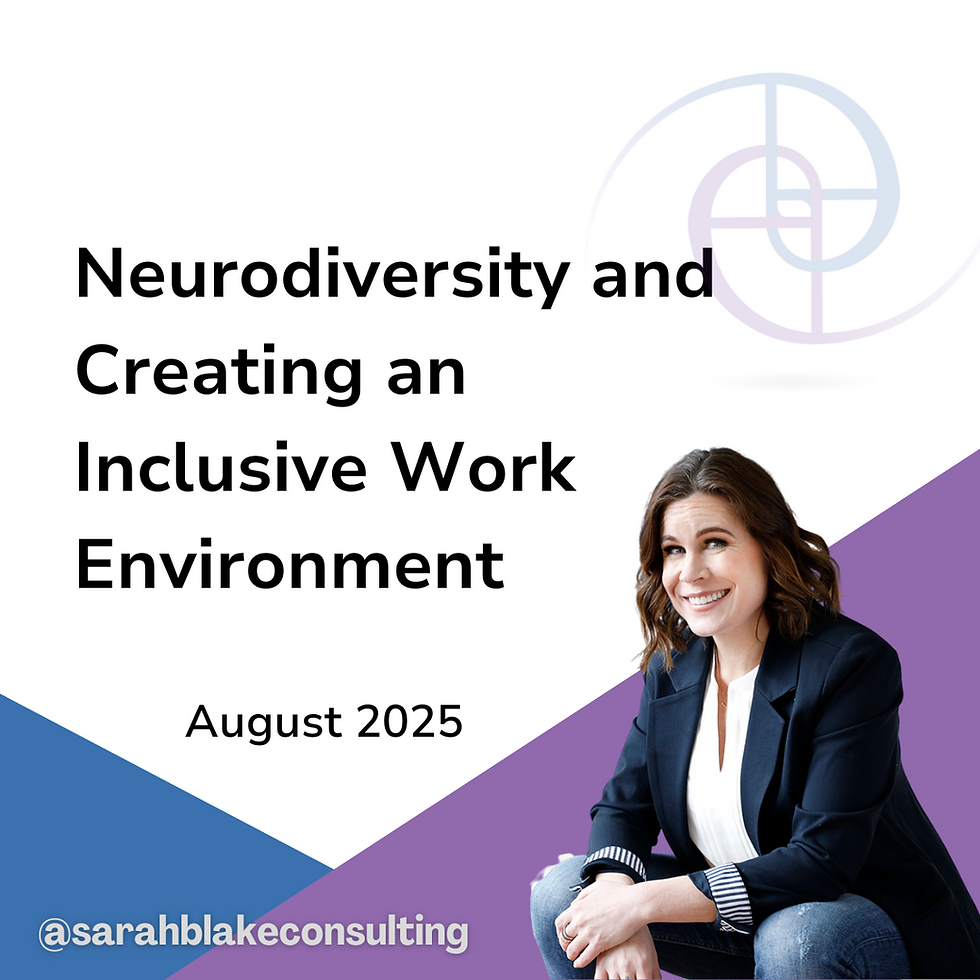Neurodiversity and Creating an Inclusive Work Environment
- Sarah Blake

- Jul 19
- 2 min read
Fostering psychological safety and a culture of acceptance is critical for neurodivergent employees to thrive. This involves leadership commitment, awareness training for all staff, open communication about neurodiversity, and tailored accommodations. Simple adjustments like flexible schedules, quiet spaces, and assistive technologies can make a big difference.
Neurodiversity in the workplace has become an increasingly important aspect of diversity, equity, and inclusion (DEI) initiatives. Creating an inclusive work environment for neurodivergent individuals not only benefits employees but also provides significant advantages for organizations.
Understanding Neurodiversity
Neurodiversity refers to the natural variation in human neurological and cognitive functioning. It encompasses conditions such as autism, ADHD, dyslexia, and others. Approximately 1 in 7 people are considered neurodivergent, making it a significant portion of the workforce.
Benefits of Neurodiversity in the Workplace
Embracing neurodiversity can bring several advantages to organizations:
1. Unique Strengths: Neurodivergent employees often possess exceptional skills in areas such as pattern recognition, attention to detail, and problem-solving.
2. Innovation: Different thinking styles can drive innovation and creativity. For example, an SAP employee developed a technical fix that saved the company an estimated $40 million.
3. Productivity: Some companies report that neurodivergent employees are significantly more productive than their neurotypical counterparts. JPMorgan found that autistic employees were 48% faster and up to 92% more productive in certain roles.
4. Enhanced Reputation: Companies that actively support neurodiversity are often seen as progressive and inclusive employers, attracting top talent from a wider pool.
Creating an Inclusive Work Environment
To foster a neuro-inclusive workplace, organizations can implement the following strategies:
1. Adapt Recruitment Processes
- Rethink traditional interview methods that may disadvantage neurodivergent candidates.
- Implement skills-based assessments to evaluate candidates based on their abilities rather than social norms.
2. Provide Workplace Accommodations
- Offer flexible work arrangements, such as remote work options or adjustable schedules.
- Create quiet spaces or sensory-friendly environments to accommodate different sensory needs.
3. Implement Training and Awareness Programs
- Educate managers and employees about neurodiversity to foster understanding and dispel misconceptions.
- Provide training on effective communication and collaboration with neurodivergent colleagues.
4. Establish Support Systems
- Develop mentorship programs or support groups for neurodivergent employees.
- Assign workplace buddies to help new hires navigate the organization.
5. Focus on Strengths
- Identify and leverage the unique talents of neurodivergent employees.
- Match individuals to roles that align with their strengths and interests.
Companies Leading the Way
Several organizations have implemented successful neurodiversity programs:
- SAP: Pioneered the Autism at Work program, which has a 90% retention rate for employees on the autism spectrum.
- Microsoft: Offers a specialized hiring program for autistic candidates.
- EY: Established Neuro-Diverse Centers of Excellence to drive innovation and leverage regional diverse workforces.
- JPMorgan Chase: Implemented the Autism at Work program, which has grown to include over 150 employees in eight countries.
Conclusion
Creating an inclusive work environment for neurodivergent individuals is not just about compliance or social responsibility; it's a strategic advantage. By embracing neurodiversity, organizations can tap into a wealth of talent, drive innovation, and create a more inclusive culture that benefits all employees. As the workplace continues to evolve, recognizing and supporting neurodiversity will be crucial for companies looking to thrive in an increasingly diverse and competitive landscape.
perplexity.ai helped with this article





Comments